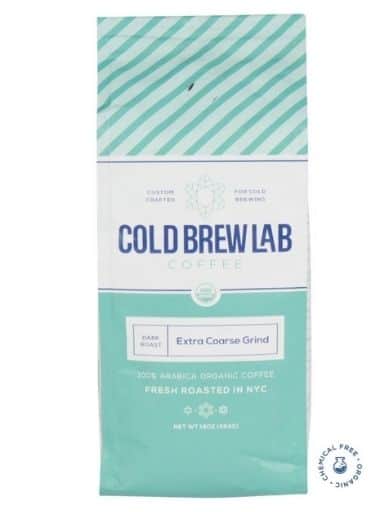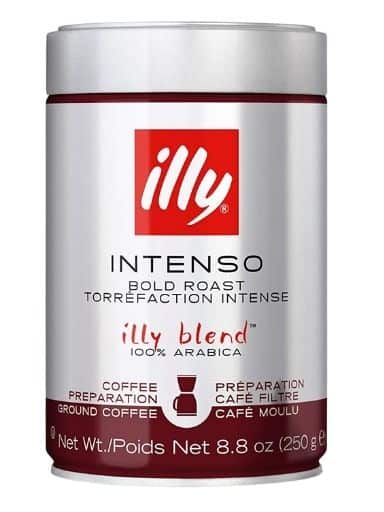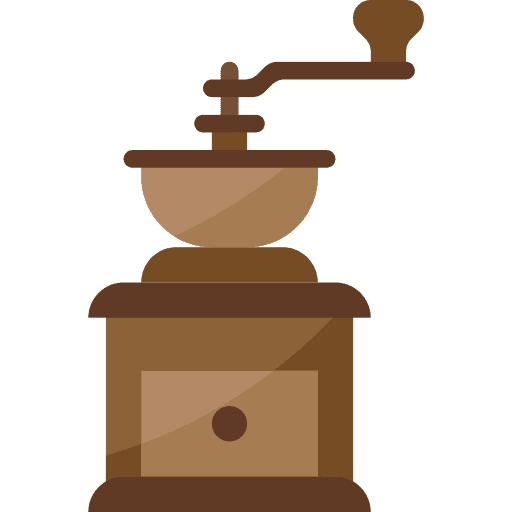fbq('trackCustom', 'view_shop_coffee'); var trackEvent = 'shop_coffee'; Growing up, instant coffee was a vile thing that…
We are in a good place in coffee history.
Comparable to our advances in technology. More than ever, people are very knowledgeable about the coffee they are drinking and the different methods of preparing it.
Cold Brew and French Press have found a new place at home, and in the coffee shop. That’s why we see a trend in coarse ground coffee brands.
But, although these methods are simple, they require the use of coarse ground coffee. The difference between an ordinary and a great coffee experience depends a lot on coarse coffee.
Let’s see why.

If we could simply squeeze the goodness out of a coffee bean, like we do with orange, coffee grind size would not be an issue.
Yet, the contact between the water and the ground beans impacts our drink’s flavor the most. Aside from caffeine, isn’t that what we want in a decent cup of coffee, a great-tasting cup? If we grind too fine, our drink will taste bitter. If it’s too coarse, a weak drink. To make up for one or the other, our contact time needs some serious adjustment.
Sometimes, we could alter the water temperature, but even there, we’re limited. Water boils at 212 degrees and not past that. If it’s too coarse, we would have to use way too much coffee, to compensate and still not come up with something drinkable.
If our coffee is too fine, it will take a longer time for the water to flow through the grounds and filter. Some concentration of nasty flavors would linger. The opposite is also true. Flowing too fast would barely extract anything tasty, because of the low contact time between coffee and water. The grind size will also affect your choice of brewing method, as you’ll see as you continue on.
Coarse coffee is ideal for making French press, cold brew, and percolator coffee. The three methods need the correct grind to use the equipment without “mechanical” problems or, worse, extractions issues.

Even though you can technically use any coffee in a French Press, it’s made to use coarser ground coffee.
The mesh filter would let small coffee ground particles sip through, and these don’t make your coffee experience too desirable. Your contact time with boiling water would be too great. Depending on your coffee variety, you’ll perceive too much bitterness. You could reduce the contact time, but the composition of your drink would be very complex. Components that normally filter out are now in your cup. They won’t poison you, but don’t taste good.

Using ground coffee in a percolator will yield a nice tasting cup of coffee. The process is very similar to using a French press.
However, it adds a bit of turbulence to the coffee grounds as the boiling water rises to the top at intervals. So using too fine a grind will extract off-flavors as well. Just like with the French press, fine grind coffee produces a muddy drink. Using coarser coffee is key to using a percolator without problems.
If you want a cross between an espresso and French press coffee, then don’t follow our advice, and you’ll end up with a drink that looks like swamp water.

I must admit that this is my favorite way of using this type of grind. Cold brewing is the total opposite of French pressing.
If one extracts all (or most) components from the bean, the other extracts the most desirable ones only. Many people with acid reflux problems can now enjoy the energizing effect of coffee, using this method.
Using coarser coffee in cold brewing ensures a balanced extraction. In this method, the grounds sit submerged in water for hours, 16-24 in most cases. (I like 16 for dark blends, 20 for lighter ones). The grind here could be as coarse as the one used for the French press. A little coarser works better. You could even use whole beans. However, cold brewing time has to be longer.
The last, but important, is the cleanup. It’s a lot easier to clean your equipment. Fine coffee makes a mushy mess. I know people in a café that quit making cold brew because they didn’t want to deal with the mess. The problem with them was, the coffee was not coarse enough. Their experience was frustrating.
Of course, with this method, you’ll extract more if the grind is fine, but other undesirable nasty flavors as well.
With all three methods, a coarser grind affects the quality of our drink. Although we can always adjust the other variables (water, time, and turbulence), in our discussion so far, we’ve seen the important role a coarser grind has in coffee quality.
Since we are on top of the coffee world in our times, it’s not so difficult to find coarse ground coffee brands to suit our needs.

This artisanal coffee is specifically ground for cold brew. It’s 100 percent Colombian Supremo. Although roasted dark, you can still enjoy a clean, smooth, low acid drink. One secret to their consistency is the fact they roast in small batches.
They also purchase, ethically, organic beans and fair trade.
They recommend you use the 4:1 ratio formula for a cold brew and let it sit for 12-24 hours. (That is 4 parts water to 1 part coffee).
You could also use this coffee for the French press and come up with a delicious cup of coffee.

This blended cold brew ground coffee, it’s a smooth and sweet blend from Guatemala, Peru and Nicaragua. If you ever tasted these as single origins, you’ll appreciate the balance they achieve together. Peruvian coffee is unique and as part of this blend, it kicks it up a notch. The beans are Fair Trade Organic.
As a company, Bizzy tastes their cold brewing seriously. They even show you how to make cold brew in a French press. No need for expensive equipment, simply ingenuity. And yes, you could enjoy it hot as well.

For those who like a bolder taste, Stone Cold Jo might prove to be the next best coffee., ever. Stone Cold Joe is 100 percent Arabica, Organic and Kosher, roasted to satisfy the coffee lover. The company founder started roasting coffee at home for friends and family. They pay attention to detail. From humble beginnings, the company grew to become a household favorite. You can enjoy this silky and chocolaty coffee, hot or cold.

Primo’s Coffee Company sources this coffee from Nicaragua. They roast in Texas and claim never to blend their product. This is good for consistency. It’s direct-trade coffee, always from the same family-owned lots. The medium roast ensures a well-balanced flavor for this single-origin coffee. They grind coarse enough to cold brew, but even better, in a French press. You could try it as a pour-over but may need to adjust the proportions.

Don’t let the name deceive you. There’s nothing but Colombian Supremo in this coffee. Although dark, you’ll notice two color profiles, darker beans than medium. This blend of profiles ensures a smooth, full-bodied taste. From experience, I prefer Colombian light to medium. They have come up with the right ratio of medium and dark beans. They grind it coarse enough specifically for cold brewing. Their recipe calls for 12-15 hours for the cold brew process, a rule of thumb with all dark blends.

Most cold brew enthusiast, drink it plain, straight up, even unsweetened. Having French vanilla once in a while can change a routine. This dark roast Colombian Supremo is naturally flavored. It’s not too overpowering, keeping the natural body of this variety. It contrasts well with the dark beans. They hint a nuttiness that makes you wonder if they added any nuts to it. They didn’t. It’s 100 percent Colombian Supremo.
Their recipe calls for a 3:1 ratio for cold brew, or 1:1 if you want a concentrate. With flavors coffees, you want to cut down your cold brewing time, especially if you prefer to do it at room temperature.

Can it get better? The Chosen bean lives to its name. A blend of Guatemala, Sumatra, Ethiopia, and Mexico beans will yield a delicious cold brew. They roast this blend light-medium and dark-medium, as each bean complements the other. We could say that each bean improves the other. I have to confess that Ethiopian is my favorite coffee. It makes me feel like if I was on vacation. Yet, as a component in this blend, it contrasts well with the Sumatra. You should get a good extraction after 16 hours.

Just as the name hints, this blend is “intense.” Illy shows that they only offer the best coffees in this blend. They use 9 Arabica coffees from around the world. It’s roasted dark to hint at notes of dark cocoa. If you’re looking for a robust, full-body blend, Illy is your blend.
This coffee is not as coarse as the ones we’ve reviewed already. But they say you can use it with a French press. Therefore, a superb choice for other methods like cold brewing, pour overs, and percolator. Not the perfect grind, but not bad.
Illy has an 80-year reputation that’s known worldwide, a synonym of quality. Tradition plays a dominant role in the choice of components in their blends. If you want a vivid start to your day or a midday pick-me-up, try the Intenso.

Continuing this trend on tradition, Café Du Monde follows the tradition of mixing coffee and chicory. This was first done as a way of extending the coffee supplies in France and her American territories during a blockade. However, it was the Dutch who tried it first and in their trade dealings influenced other cultures.
This is as bold as it gets. Remember, they are following a coffee tradition from a different time, when bold and bitter were kings. Café Du Monde, mixes chicory and coffee. You can enjoy it, hot or by using any of the other methods. It’s not as coarse as our first reviews, similar to the Illy Intenso.
Depending on your palate, or if you’re curious, watch your water to coffee ratios. If cold brewing, let the coffee sit for 8 hours tops.

Our last one, the Gevalia Reserve Guatemala, is the total opposite. They roast the 100 percent Guatemala beans medium to keep their natural smoothness. This blend is ground coarse enough for the French press. You may need to adjust the ratios here too. Maybe you’ll want to double the amount of coffee if you’re looking for a bolder, sweet taste.
When cold brewing, 24-36 hours will produce a flavorful, ready to drink beverage.

As a coffee connoisseur, you probably have the equipment you need to enjoy all these coffees. With a French press, you can make the best tasting cold brew ever. You need nothing else if you pay attention to a few things.
Your most important ingredient in coffee is water. Did I shock you? Well, if it sounds better, let’s say more “prominent.” About 97 percent of the coffee in your cup is water, only 3 percent coffee grounds. Clean tasting fresh water will always guarantee a good extraction.
When cold brewing, you want to use water that’s 40 to 100 degrees. I would use room temperature or filtered water from the tap. Where I live, the water comes out of the faucet at about 60 degrees, sometimes lower depending on the season. Now, after mixing my coffee and water together, I would put it in the refrigerator. That means that my water temperature will drop to 40 degrees. This change, the force generated to cool down, aids in the extraction. The same is true if you leave your cold brew outside at room temperature. The colder water will warm up to room temperature and, like the refrigerated option, extract an excellent coffee. These drastic changes have a positive effect on your brew.
Although the maximum temperature is 100 degrees, you want to stay in the lower temperature range. Water that sits, for long periods of time, at above 100 degrees, may develop microscopic pathogens. Exercise caution.
Always use the coffee profile that you love. The proportions are up to the individual. A safe way to start is a 5:1 ratio. Remember that you will end up with about 30 percent, or more, caffeine than if hot brewing. You are using more coffee grounds. Additionally, your brew will sit for a long time, extracting loads of caffeine. Caffeine is very soluble compared to the other components in a coffee bean.

There many are affordable grinders out there. See my review.
But what if you don’t want another gadget? There are a few things few you can do. It’s simple how-to ground coffee at home.
You could use a mortar, but a dedicated one. You don’t want to end up with garlic tasting coffee. Or, you could use a cup and something to crush the beans with. Remember that you don’t need to pound hard. Most varieties of coffee will crush easily. Just use small quantities at a time. It won’t be a perfect, even grind, but good enough.
Another option is to use a clean kitchen cloth, fill it with small pockets of beans, and crush them with a rolling pin or an empty bottle. These are life hacks when no other options are available. Cold brewing is more forgiving of the uneven grind size.
You can alternately use a food processor. A few months back, I ran out of ground coffee. It was early in the morning and my grinder failed. It was completely dead!. So, my Magic Bullet did the trick. I actually went a little too fine. But getting a coarse grind this way is easy, just let it go. You might need a pulse or two to get the right grind. Learning how to ground coffee at home takes practice, patience, and ingenuity.
Technically, you can use whole or half crush beans to make a cold brew or even French press. The problem with that is you’ll extract a weaker coffee and waste expensive beans. One advantage of doing it this way is an easier cleanup.
A cup of coffee beans and a cup of ground coffee have the same amount of caffeine. Nothing miraculous happened in the grinding process that would raise the caffeine content.
But, there’s always a “but”, uh? Finer coffee will come in contact more with the water and extract caffeine that probably wouldn’t have been extracted if the grind was coarser. Coarser coffee will come in contact with the water, less and therefore extract less caffeine.
That said, cold brew has more caffeine than regular coffee. Why? Please note that all recipes call for loads of coffee. Some go as far as a 1:1 ratio. Coarser coffee, in this context, will yield more caffeine per cup just because you are using more.

The places where to find coarse coffee can get interesting.
Most local cafés sell beans to the public and will gladly grind it for you. Tell them what you need it for, and they’ll even give you pointers on how to use it. Others already sell it ground, ready to use, as a regular item.
Your best option where to buy coarse ground coffee is the Internet. One particular roaster and importer in the Northeast will accommodate any order and ship even overseas. With over 100 years’ experience, they’ve seen trends come and go. You could get coarse and even pulverized coffee if it suits your needs. They also sell Fair Trade Organic. Look them up if you are interested.
Our picks include a great variety of profiles bound to please most people. So follow our links and get good money to quality ratio. Get it? money to quality.
Nevertheless, doing it yourself is king. I have a friend who does not trust that task to anyone. She even roasts her beans in a pan.
It’s never been better in the coffee industry. Our choices are as diverse as we are.
The winner of our roundup is Stone Street Coffee. There’s no way you can go wrong. This Brooklyn roaster produces high-quality coffee. That they roast in small batches, guarantees consistency time after time.
Something outstanding is just the fact that they tailor their coffee for cold brew. The grind size is ideal for this. You won’t over-extract that easily if you forget to filter your brew on time. We all forget things. Although you’ll get a decent cold brew out of the other brands, some are not coarse enough or not roasted with cold brewing in mind (e.g., Illys and Café Du Monde).
However, any of the coffees in this review would do. Try one a week or a month at a time and compare them. One in particular to try is the Chosen bean. Those beans are so well-balanced that it would be a pity to pass on. You’ll also notice a difference in your extraction times if you cold brew it.
Enjoy all of these coarse ground blends and play with all kinds of brewing methods. Some will work better than others. Experiment a little (or a lot). After all, what could go wrong? Caffeine high?
